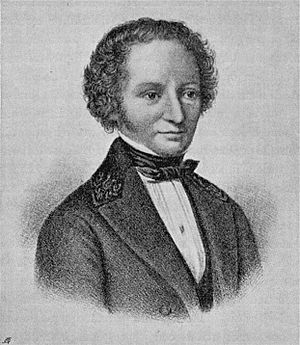Per Daniel Amadeus Atterbom facts for kids
Quick facts for kids
Per Daniel Amadeus Atterbom
|
|
|---|---|
 |
|
| Born | 19 January 1790 Pålsbo, Åsbo |
| Died | 21 July 1855 (aged 65) Stockholm, Sweden |
| Occupation | Professor |
| Language | Swedish |
| Alma mater | University of Uppsala |
| Genre | Poetry |
Per Daniel Amadeus Atterbom was a famous Swedish poet who lived from 1790 to 1855. He was known for his romantic poetry and was an important member of the Swedish Academy.
Contents
Early Life and Studies
Per Daniel Amadeus Atterbom was born on January 19, 1790, in a place called Åsbo in Östergötland, Sweden. His father was a country parson, which is like a local priest.
He went to the University of Uppsala to study. He was a student there from 1805 to 1815. Later, in 1828, he became a professor of philosophy at the same university.
Starting a New Movement
Atterbom was a very important person in the romantic movement in Swedish literature. This movement changed how Swedish writers wrote. It was a big shift from older styles.
In 1807, when he was just 17 years old, Atterbom started an art group in Uppsala. It was called the Aurora League. Many young writers who later became famous were part of this group. Some of them were V. F. Palmblad and Anders Abraham Grafström.
Literary Journals
The Aurora League first tried to make a newspaper called Polyfem. It wasn't very good and didn't last long. But in 1810, Atterbom started a new journal called Fosforos. This one was much more successful and became a classic in Swedish literature.
Fosforos was full of poetry and essays about art. It helped introduce the new Romantic style of writing from Germany to Sweden. Many early works by Atterbom and his friends were published in this journal.
Later, the Aurora League also created the Poetisk Kalender (1812-1822) where their poems appeared. They also started a new critical journal called Svensk Litteraturtidning (1815-1824).
Famous Works
One of Atterbom's most famous works is Lycksalighetens Ö, which means The Fortunate Island. It's a romantic play that was published in 1823. People thought it was very beautiful.
Before that, he wrote a collection of poems called Blommorna (The Flowers). These poems were a bit mysterious. He also started a fairy tale play called Fågel Blå (The Blue Bird). Only a small part of it is still around, but it's considered one of his best writings.
Atterbom was a great poet, but sometimes his longer works were a bit confusing. This was because he liked to use a lot of hidden meanings and symbols in his stories.
Later Life and Legacy
As he got older, Atterbom became less involved in arguments about literature. In 1835, he became a professor of art and literature at Uppsala University. Four years later, he was chosen to be a member of the Swedish Academy. This is a very respected group in Sweden that works to improve the Swedish language and literature.
Per Daniel Amadeus Atterbom passed away on July 21, 1855.
He wrote a series of books called Svenska Siare och Skalder. These books were biographies of Swedish poets and writers. They are a valuable source for learning about Swedish literature up to the "classical" period. His complete works were collected and published in 13 volumes between 1854 and 1870.
Poetry
- Blommorna (The Flowers)
- Fågel Blå (Blue Bird) (1813)
- Lycksalighetens Ö (The Island of Bliss) (1824-1827)
See also
 In Spanish: Per Daniel Amadeus Atterbom para niños
In Spanish: Per Daniel Amadeus Atterbom para niños

